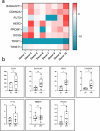Development of a novel gene expression panel for the characterization of MSCs for increased biological safety
- PMID: 39621192
- PMCID: PMC12367896
- DOI: 10.1007/s13353-024-00917-5
Development of a novel gene expression panel for the characterization of MSCs for increased biological safety
Abstract
Mesenchymal stromal cells (MSCs) have a wide range of therapeutic applications due to their multipotency, immunomodulatory, and anti-inflammatory properties. Their ability to migrate and recolonize damaged tissues is also remarkable. However, the controversial occurrence of spontaneous tumorigenesis or malignant transformation of MSCs raises concerns about proposed cell-based therapies for patients that researchers must address. There are several in vitro and in vivo strategies for MSC safety approval, but there is still no described coherent scheme that allows the assessment of MSC oncogenic potential in a simple, robust, and reproducible manner. Here, we have developed a diagnostic panel of molecular markers that allows for the accurate verification of the quality and safety of MSCs. Moreover, presented in this article diagnostic panel that can define the origin and tumorigenicity of MSCs can be easily introduced into the routine quality control processes of MSC-based product manufacturing which will improve further clinical applications of MSCs.
Keywords: Cancer risk assessment; Cell therapy; MSCs; Mesenchymal stromal cells; Oncogenic potential.
© 2024. The Author(s).
Conflict of interest statement
Declarations. Ethical approval: This study was performed in line with the principles of the Declaration of Helsinki. Approval was granted by the Ethics Committee. Consent to participate: Written informed consent for the transfer of biological material for research purposes was obtained from all MSC donors. Competing interests: TO is an employee of Polski Bank Komórek Macierzystych S.A. (FamiCord Group), Board Member of FamiCord Group. TK is Director of Research and Development Department, Polski Bank Komórek Macierzystych S.A. IZM is employee of Polski Bank Komórek Macierzystych S.A. (FamiCord Group). ARB, IMS, and MW are past employees of Polski Bank Komórek Macierzystych S.A. (FamiCord Group). NR is an external expert of Polski Bank Komórek Macierzystych S.A. (FamiCord Group).
Figures





References
-
- Abdelalim EM, Tooyama I (2012) The p53 inhibitor, pifithrin-α, suppresses self-renewal of embryonic stem cells. Biochem Biophys Res Commun 420(3):605–610. 10.1016/j.bbrc.2012.03.041 - PubMed
-
- Barkholt L, Flory E, Jekerle V et al (2013) Risk of tumorigenicity in mesenchymal stromal cell based therapies — bridging scientific observations and regulatory viewpoints. Cytotherapy 15(7):753–759. 10.1016/j.jcyt.2013.03.005 - PubMed
-
- Bianco P (2014) Mesenchymal stem cells. Annu Rev Cell Dev Biol 30:677–704. 10.1146/annurev-cellbio-100913-013132 - PubMed
MeSH terms
Grants and funding
LinkOut - more resources
Full Text Sources

